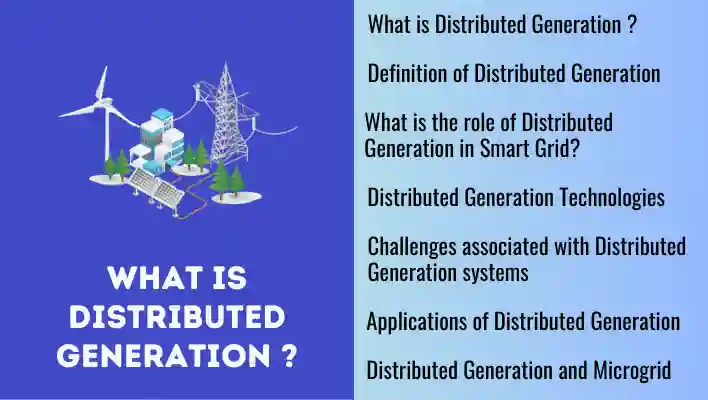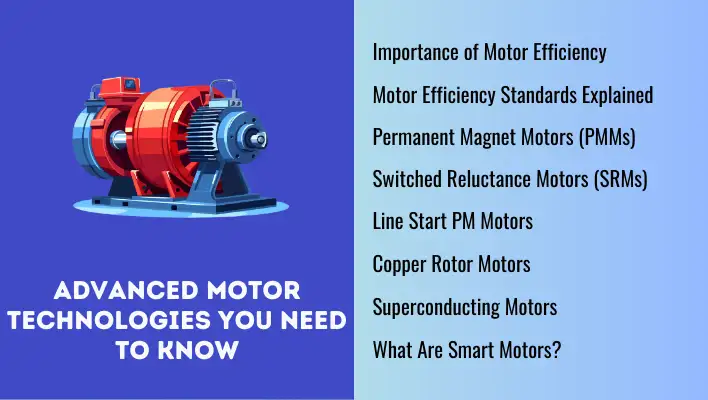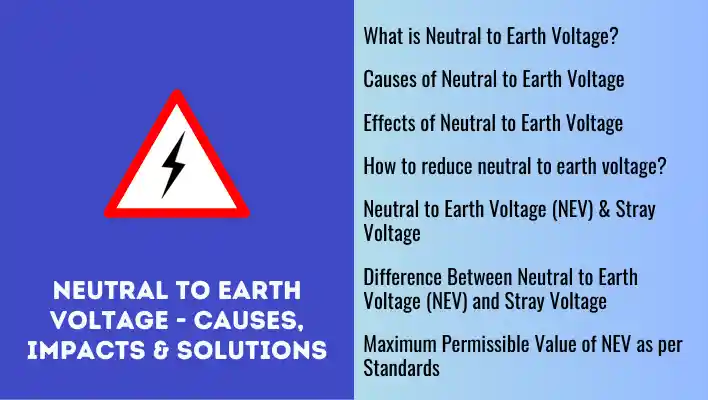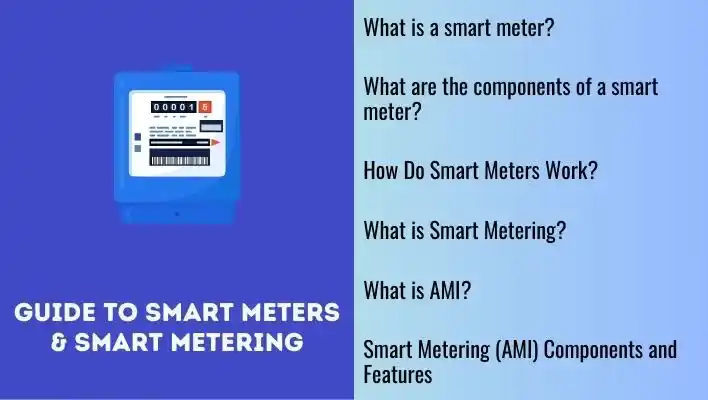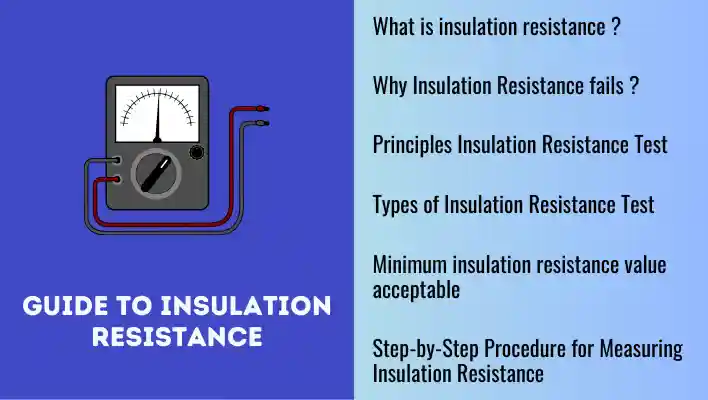Distributed generation (DG) revolutionizes energy production with localized generation near consumption points. DG encompasses diverse technologies like solar PV and wind turbines. Integrating DG into smart grids poses challenges, yet its potential applications are vast, from enhancing grid stability to enabling demand response. Join us as we explore Distributed Generation’s definition, technologies, smart grid role, challenges and its applications.
Also Read: Smart Grid | The Ultimate Guide
What is Distributed Generation ?

In conventional electricity systems, power is generated at large centralized plants situated far from end-users. These plants typically harness energy from fossil fuels and convert it into electricity with the help of turbines and generators.
The resulting electrical output is at low voltage, but is then transformed to high voltage via a step-up transformer for efficient transmission through the grid. This high-voltage electricity travels through transmission networks to reach the distribution stage.
As the electricity enters the distribution network, its voltage is reduced through step-down transformers, before reaching consumers.
However, due to concerns regarding climate change and energy security, there’s a growing movement towards integrating large renewable energy generators into the existing power grid systems.
Also, electricity prices were going up because fossil fuels were getting more expensive, and there were big investments in distribution networks to handle the growing demand from energy-intensive appliances like air conditioners. Such appliances can place significant strain on the network, especially during peak demand periods such as hot days.
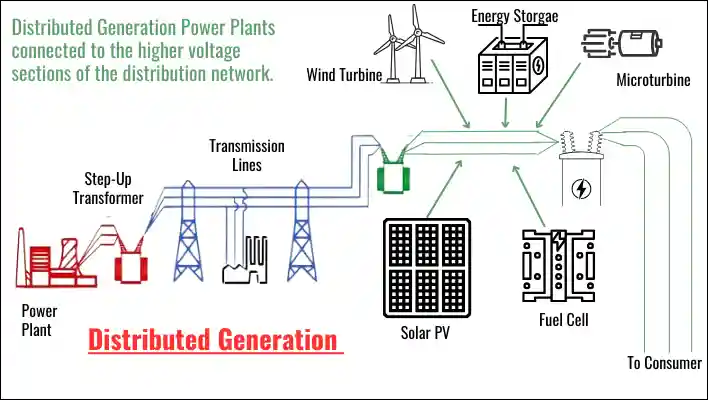
To address this issue and mitigate transmission and distribution losses, renewable energy systems or small scale conventional power plants such as diesel generators are often connected to the higher voltage sections of the distribution network.
This strategy involves generating electricity closer to the point of consumption, thereby alleviating stress on the grid and improving overall system efficiency. This localized generation approach is commonly known as distributed generation (DG).
Distributed generation is also known as Embedded Generation and Dispersed Generation in South America and North America respectively. In Europe and Asia, the term ‘decentralized generation’ is used for Distributed Generation.
Also Read: Power Supply System | A Comprehensive Guide
Definition of Distributed Generation
Presently, no universally accepted definition exists, but a report by IEA on Distributed Generation in Liberalised Electricity Markets provides the following definition:
Distributed generation is generating plant serving a customer on-site or providing support to a distribution network, connected to the grid at distribution-level voltages.The technologies generally include engines, small (and micro) turbines, fuel cells, and photovoltaic systems. It generally excludes wind power, since that is mostly produced on wind farms rather than for on-site power requirements.
The definition from the IEA lacks details regarding generation capacity, operational mode, power delivery scope, or ownership, which would have clarified the limitations on technology or capacity for potential distributed generation applications.
Apart from IEA, numerous definitions of distributed generation exist, including various generation setups. While some definitions cover larger co-generation units or large-scale wind farms linked to the transmission grid, others highlight small-scale generation units tied to the distribution grid.
These definitions collectively imply that small-scale generation units connected to the distribution grid should be regarded as part of distributed generation.
A widely known research paper authored by Thomas Ackermann, Goran Andersson and Lennart Soder gives detailed explanation about the number of definitions that are based on purpose, location, rating, technology, mode of operation and penetration of distributed generation.
As these variations of definitions would create confusion, the authors have suggested a general definition as well as categories for Distributed Generation. The definition is as follows,
Distributed generation is an electric power source connected directly to the distribution network or on the customer site of the meter.
The authors have not included any ratings of the generations in the definition as the maximum rating depends on the local distribution network conditions, e.g. voltage level.
The categories proposed for distributed generation are four types,
| Micro distributed generation | 1 Watt to 5 kW |
| Small distributed generation | 5 kW to 5 MW |
| Medium distributed generation | 5 MW to 50 MW |
| Large distributed generation | 50 MW to 300 MW |
In conclusion, while small-scale generation is often referred to as distributed generation, there is no decisive definition of distributed generation based on its technologies and numerous applications in diverse environments.
Also Read: What is interconnected power system or grid?
What is the role of Distributed Generation in Smart Grid?
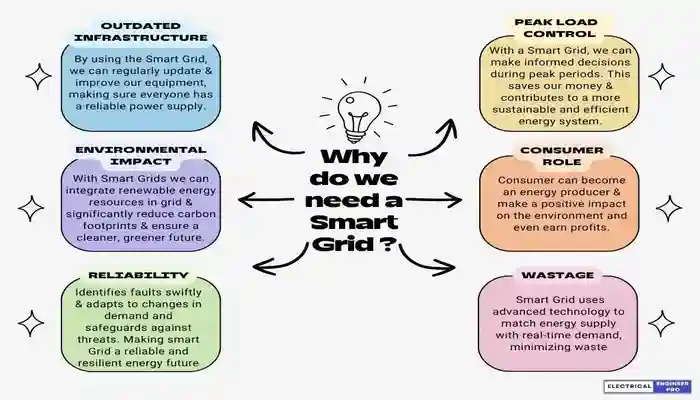
Distributed generation (DG) plays a pivotal role in the evolution and efficacy of smart grids. DG encompasses various small-scale power sources located near or within consumer premises, thereby decentralizing energy production. This decentralization fosters several crucial functions within smart grids:
Integration of Renewable Energy Sources: DG facilitates the integration of renewable energy sources like solar, wind, and hydro power. By distributing these sources throughout the grid, smart grids can diversify energy inputs, reducing reliance on centralized fossil fuel-based generation and advancing sustainability.
Enhanced Grid Resilience: The decentralization brought about by DG enhances grid resilience by reducing the impact of single points of failure. With power generation distributed across multiple locations, the grid becomes immune to widespread outages, maintaining overall reliability.
Reduced Transmission Losses: Locating DG closer to consumption points minimizes transmission losses associated with transmitting electricity over long distances. Reduction in losses enhances efficiency and costs for both utilities and consumers are also decreased.
Voltage Support and Power Quality Improvement: DG assists in mitigating voltage fluctuations and enhancing power quality within the grid by strategically introducing power at various locations. This becomes increasingly important as smart grids incorporate intermittent renewable energy sources, thereby managing the load variations.
Peak Load Management: DG serves as a tool for managing peak demand by providing additional generation capacity during periods of high electricity consumption. This capability enables utilities to avoid or delay investments in costly peaking power plants and infrastructure upgrades.
Facilitation of Demand Response Programs: Smart grids rely on DG to support demand response initiatives, where consumers adjust their electricity usage in response to grid signals. DG resources motivates consumers to reduce electricity consumption during peak periods or shift usage to times of high renewable energy generation.
Support for Microgrids: DG forms the backbone of microgrids, localized energy systems that can operate independently or in tandem with the main grid. Microgrids powered by DG offer increased resilience, energy independence, and autonomous operation during grid outages.
Overall, DG plays a crucial role in enhancing the flexibility, reliability, and sustainability of smart grids by decentralizing power generation and integrating renewable energy sources. These functions collectively contribute to the advancement of modern grid infrastructure towards a more resilient, efficient, and environmentally sustainable energy future.
Also Read: Understanding Conventional Power Plants – A Detailed Exploration
Distributed Generation Technologies
Different technologies are used for distributed generation. The technologies include Renewable and Nonrenewable technologies. The below chart show the classification of different technologies which are also discussed in brief details,
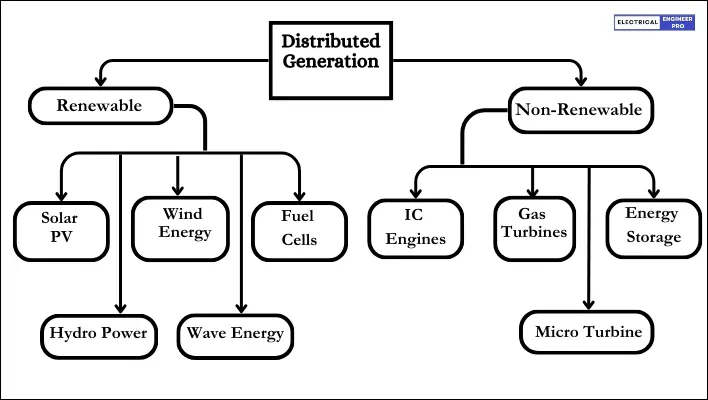
Reciprocating Internal Combustion Engines
Reciprocating internal combustion engines works excellently in various distributed generation applications, finding widespread use across industrial, commercial, and institutional settings for both power generation and combined heat and power (CHP) systems.
They are easily available, cheap to manufacture, good after sales services such as repair and maintenance. However, reciprocating engines do have their drawbacks. They are known for noise pollution, costly maintenance and associated high emissions, particularly nitrogen oxides.
Gas Turbine
Gas turbine generators designed for distributed generation and co-generation typically range in capacity from approximately 700 KW to about 50 MW. They are adaptable to various gas or liquid fuels, including distillate fuel oil, propane, natural gas, bio-gases, and synthetic gases.
These generators boast excellent reliability, particularly when employed for continuous duty operation, with achievable availability rates ranging from 90 to 98 percent.
Although gas turbine generators exhibit slightly lower efficiency, they excel in low load factor applications such as peaking generation, grid support, standby service, and mobile grid-support units.
Their emissions are moderately lower than those of reciprocating engines, primarily due to the availability of commercially viable Nitrogen Oxides emissions-control technology.
Energy Storage
Energy storage in distributed generation encompasses various components such as batteries, flywheels, and other devices. These components are charged during periods of low demand and utilized as needed. Typically, they are integrated with different types of distributed generation systems to meet peak load demands efficiently.
Micro Turbines
Microturbines, compact gas turbine generators ranging from 30 to approximately 250 kW, comprise a compressor, combustor, recuperator, small turbine, and generator in a simplified structure.
Unlike traditional combustion turbines, microturbines operate at lower temperatures and pressures, with faster speeds (up to 100,000 rpm), sometimes eliminating the need for a gearbox.
They operate on fuels like natural gas, biogas, propane, butane, diesel, and kerosene. Microturbines offer quiet operation and a compact footprint. Moreover, they emit significantly lower air pollutants compared to uncontrolled reciprocating engines.
However, microturbines face challenges such as limited operational history and relatively high costs when compared to gas engines.
Wind Energy
Wind energy is a well-established source that has been utilized for decades. A typical wind turbine comprises a rotor, turbine blades, generator, drive mechanism or coupling device, shaft, and the nacelle housing, which contains the gearbox and generator drive.
These modern turbines are capable of producing clean electricity either individually or as part of wind farms. Typically, wind turbine blades range from two to three in number, each approximately 10–30 meters in length.
While larger wind turbine farms exhibit energy characteristics similar to centralized sources, smaller wind turbines, acting as modules, can be integrated with photovoltaic (PV) and battery systems to cater to an area’s energy needs ranging from 25 to 100 kW.
Small wind turbines find various applications, including powering remote residential areas, telecommunications infrastructure, water pumping systems, and village power grids in isolated regions or under-served areas of developing countries lacking reliable grid access.
Wind turbines find applications in various settings, including remote residential areas, telecommunications infrastructure, water pumping, and village power systems. They prove particularly beneficial in remote locations or developing countries lacking dependable grid service.
Solar PV
A typical grid-connected photovoltaic (PV) power generation setup comprises an array of flat-plate modules or building-integrated PV products, along with collector wiring, a DC disconnect, an inverter for converting DC module output to alternating current (AC), an AC grid disconnect, protective relays, and metering equipment.
In contrast, grid-independent systems, which do not rely on grid connection, may omit grid disconnection components and inverters if loads operate on DC. However, such systems may incorporate batteries, charge controllers, and backup generation equipment.
Solar energy can be strategically employed during peak loads to align with peak points on the load curve. For instance, during summer days, PV systems can supply surplus power needed for air conditioning and cooling processes, with any excess power being fed into the grid. This obviates the necessity for “dispatchable” power sources.
Fuel Cell
A fuel cell functions as a device for generating electric power and supplying thermal energy by converting chemical energy through electrochemical processes. It operates akin to a continuously fuel-fed battery, continuously delivering electric energy as long as fuel is provided. Further Fuel Cells do not require periodic recharging since the materials involved in the electrochemical reaction are continually replenished.
Fuel cell capacities range from kilowatts (kW) for portable units to megawatts (MW) for stationary installations. They offer a clean power and heat source for various applications, utilizing gaseous and liquid fuels. Fuel cells have the versatility to utilize a range of hydrogen-rich fuels including natural gas, gasoline, biogas, or propane.
What are the challenges associated with Distributed Generation systems?
There are several important and key issues, and challenges in the integration of the Distribution Generation system (DG) in the power systems. Such as,
Operation and Control: Coordinating the operation and control of numerous distributed generation units across a power network can be complex. Ensuring stability, reliability, and efficiency while managing variability in generation levels poses a challenge. Control strategies must be devised to manage Distributed Generation output variations, especially in renewable energy sources like solar and wind, which are intermittent by nature.
Optimal Location: Determining the best locations for distributed generation units requires thorough analysis of factors such as load demand, existing infrastructure, grid capacity, and environmental considerations. Finding optimal locations that minimize transmission losses and maximize system efficiency can be challenging.
Modelling Issues: Accurately modelling DG units and their interactions with the grid is crucial for system planning, operation, and stability analysis. Challenges arise due to the diverse types of DG technologies, their dynamic behavior, and the interaction with other grid elements.
Protection System Requirements: Integrating DG into existing protection schemes necessitates adjustments to ensure proper fault detection, isolation, and system restoration. The bidirectional power flow in DG systems can lead to challenges in coordination between protection devices, especially for islanded operations or during grid disturbances.
Change of Short Circuit Capacity: Adding DG alters the short-circuit capacity of the system, affecting fault currents and coordination of protection devices. DG units may have different fault current contribution characteristics compared to traditional synchronous generators, requiring adjustments in protection settings and coordination.
Power Quality: DG can influence power quality parameters such as voltage regulation, harmonics, and frequency stability. Variability in DG output and the integration of power electronic converters can introduce voltage fluctuations and harmonic distortion, impacting sensitive loads and system performance.
Stability: The integration of DG can affect system stability by altering the dynamics of the power grid. Challenges include managing voltage stability, frequency control, and transient stability in the presence of varying DG output and changing system operating conditions.
Commercial Issues: Distributed generation introduces complexities in billing, metering, and revenue allocation within the electricity market. Issues such as pricing mechanisms, market participation rules, and tariff structures need to be addressed to ensure fair compensation for distributed generators.
Regulatory Issues: Regulatory frameworks may need to be updated to address the integration of DG into the power system. Regulations related to interconnection standards, grid codes, safety standards, and market participation rules must be revised to facilitate DG deployment while ensuring grid reliability and safety.
Economic Factors: The economic viability of distributed generation depends on factors such as capital costs, fuel prices, and incentives. Balancing the costs and benefits of DG deployment against traditional centralized generation requires careful economic analysis and policy support.
Unbalancing: The integration of DG can lead to unbalanced loading on the grid, particularly in distribution networks. Unbalanced loading affects equipment sizing, losses, and voltage regulation, requiring mitigation strategies such as phase balancing and network reconfiguration.
Applications of Distributed Generation
Various Distributed Generation (DG) technologies serve diverse applications, each tailored to specific load requirements. Accordingly, the choice of DGs varies based on these applications. Below, are some of these applications,
Standby: Distributed generation serves as a backup power source during grid outages or emergencies, ensuring uninterrupted electricity supply to critical facilities such as hospitals, data centers, telecommunications infrastructure, and emergency response centers.
Standby DG units, often fueled by diesel generators or natural gas turbines, are designed to automatically switch on when the primary grid supply fails, providing reliable backup power until grid restoration.
Stand alone: In areas with limited or no access to centralized grid infrastructure, standalone distributed generation systems provide electricity independently of the main grid. Standalone DG solutions, such as solar photovoltaic (PV) systems with battery storage or diesel generators in remote areas, enable electrification of off-grid communities, islands, and isolated industrial sites.
Peak load shaving: Distributed generation can reduce peak electricity demand on the grid by generating power locally during periods of high demand. During peak hours, when electricity prices are typically higher, DG units, such as gas turbines, reciprocating engines, or demand response systems, can be dispatched to supplement grid supply, thereby reducing strain on centralized generation and transmission infrastructure.
Rural and remote applications:Distributed generation is particularly beneficial in rural and remote areas where extending centralized grid infrastructure is cost-prohibitive or technically challenging. Renewable energy sources like solar, wind, and micro-hydro can be deployed as distributed generation solutions to electrify remote villages, farms, agricultural irrigation systems, and other off-grid applications.
Providing combined heat and power (CHP): Distributed generation systems can be configured for combined heat and power (CHP) or co-generation, simultaneously producing electricity and useful thermal energy (e.g., heat or steam) for heating, cooling, or industrial processes.
CHP applications, often utilizing natural gas engines, fuel cells, or biomass generators, offer increased energy efficiency and cost savings compared to separate generation of electricity and thermal energy.
Base load: While distributed generation is commonly associated with flexible and intermittent renewable energy sources, certain technologies, such as biogas plants, micro-hydro systems, and co-generation units, can provide continuous, base load power.
These base load distributed generation solutions are suitable for applications requiring constant electricity supply, such as industrial processes, wastewater treatment plants, and large commercial facilities.
Also Read: Types of High Voltage Circuit Breakers | Explained
Distributed Generation and Microgrid
This detailed comparison highlights the technical differences between distributed generation and microgrids, emphasizing their control capabilities, grid connections, sizes, components, purposes, and integration requirements.
| Distributed Generation | Microgrid | |
| Definition | Distributed generation (DG) refers to small-scale power generation units connected to the distribution system, often located close to the point of electricity consumption. | A microgrid is a localized grouping of distributed energy resources (DERs), including generation, storage, and loads, coordinated and controlled as a single entity. It can operate connected to the main grid or in islanded mode. |
| Control | DG typically operates in parallel with the main grid and does not have control over grid operation. It generates electricity based on local demand and grid conditions. | Microgrids have advanced control systems that enable them to operate in both grid-connected and islanded modes. They can autonomously control generation, storage, and loads to optimize performance and respond to grid conditions. |
| Grid Connection | DG can operate connected or disconnected from the main grid. When connected, it feeds excess power back to the grid. | Microgrids can seamlessly transition between grid-connected and islanded modes. In islanded mode, they can continue to provide electricity independently of the main grid, enhancing resilience during grid outages. |
| Size | DG systems vary in size, ranging from small residential solar panels and wind turbines to larger-scale industrial generators. | Microgrids typically serve larger areas, such as communities, campuses, military bases, or industrial complexes. They can encompass multiple DERs, including solar PV, wind turbines, batteries, and combined heat and power (CHP) systems. |
| Components | DG components include various generation sources such as solar PV, wind turbines, microturbines, fuel cells, and diesel generators. They may also include inverters, meters, and protection devices. | Microgrid components comprise generation sources (renewable and conventional), energy storage systems (batteries, flywheels), loads (buildings, industry), and advanced control systems (microgrid controllers, SCADA). Additionally, microgrids may incorporate smart meters, grid sensors, and communication infrastructure for monitoring and control. |
| Purpose | DG provides localized generation near the point of consumption, reducing transmission losses and enhancing grid reliability. It can also support renewable energy integration and reduce dependency on centralized generation. | Microgrids offer energy resilience, flexibility, and the ability to optimize local energy supply and demand. They can enhance reliability, reduce energy costs, and support sustainability goals by integrating renewable energy and energy storage. Microgrids also enable the integration of electric vehicles (EVs) and demand response programs. |
| Integration | DG may operate independently of other distributed energy resources (DERs) and grid infrastructure. Coordination with the main grid is limited to grid interconnection requirements and standards. | Microgrids require integration and coordination of multiple DERs, including generation, storage, and loads. Advanced control algorithms ensure seamless operation and optimal performance under various grid conditions. Microgrids may also participate in grid services such as frequency regulation and demand response, contributing to grid stability and reliability. |
FAQs
What is distributed generation in simple terms?
In simple terms, distributed generation refers to generating electricity from small-scale sources that are located close to where the power is used, like solar panels on rooftops or small wind turbines. It’s a decentralized approach to power generation, providing energy directly to homes, businesses, or communities without relying solely on large, centralized power plants.
What are the benefits of distributed generation technology?
Distributed generation offers benefits such as increased energy resilience, reduced transmission losses, improved grid stability, and enhanced integration of renewable energy sources.
What role does distributed generation play in renewable energy integration?
Distributed generation enables the integration of renewable energy sources like solar and wind by providing localized generation that reduces dependency on fossil fuels and lowers greenhouse gas emissions.
What is the difference between DG and DER?
DG refers specifically to small-scale power generation units located near consumption points, while DER encompasses a broader range of distributed energy technologies, including generation, storage, and demand-side resources.
What is distributed generation vs centralized generation?
Distributed generation involves generating electricity close to where it’s used, while centralized generation relies on large power plants located remotely, with electricity transmitted over long distances.

